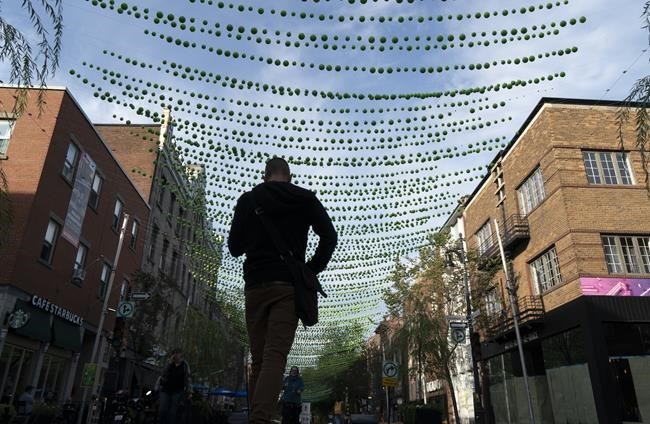
The art installation know as "18 Shades of Gay," is seen above Ste-Catherine Street in Montreal's Gay Village in Montreal on Tuesday, September 3, 2019. The Village, Montreal's historical LGBTQ neighbourhood, has become the scene of homelessness, addiction and crime, with locals suggesting that its social problems are being imported because of the district's history of being an inclusive space for marginalized people.THE CANADIAN PRESS/Paul Chiasson
July 07, 2023 - 1:00 AM
MONTREAL - The Village, Montreal's historical LGBTQ neighbourhood, has become the scene of homelessness, addiction and crime, with locals suggesting that its social problems are being imported because of the district's history of being an inclusive space for marginalized people.
Richard Fitzgerald, who has lived in the Village for 46 years, says he has witnessed a slow decline.
"Twenty years ago it was a really lively place and it was known around the world." Now, he said, "you come here at night and it's scary. There's violence. There's a whole problem of people who have drug problems, mental health problems."
In response, the city has boosted police presence in the neighbourhood just east of downtown and assigned a two-person psychosocial intervention team to direct vulnerable people to resources. In June, it released a plan to revitalize the neighbourhood and deal with homelessness and mental health.
But residents and business owners say the measures are insufficient, and they lament that the municipal government helped create the problem by concentrating services for vulnerable people into one area without the necessary investments to properly care for them.
"They don't have anywhere to go," Fitzgerald said, sympathizing with people struggling with drug and mental health problems, whom he called "victims of a system."
"This is where they come, and the city encourages it because they try to say this is an inclusive area. I think the mentality is that the gay community is more open to marginality than the rest of the city."
Christian Généreux co-organized a march Tuesday through the Village streets in an effort to get the municipal, provincial and federal governments to address the district's social ills. Généreux said his neighbourhood's problems have been partly "imposed" on it.
He pointed to the city's decision during the COVID-19 pandemic to temporarily convert a large hotel in the area into a homeless shelter. “It imported to the Village problems that are not specific to the Village,” Généreux said.
“All this combination of factors makes it so all of this is grouped in one neighbourhood, and it creates pressure, a lack of security, and as the governments don’t provide the resources needed, these people find themselves in the streets with the problems they have.”
The Village has long been a hub for community organizations and services for marginalized people, said Bruno Laprade, a spokesperson for an LGBTQ organization and local historian who has been giving tours of the neighbourhood for 17 years. Commercial vacancies following the deindustrialization of the area in the 20th century meant non-profits and other groups could take advantage of lower rents, he explained.
He says the Village's problems have been compounded by a drop in tourism due to competition from LGBTQ destinations in other cities and even from other commercial areas of Montreal.
In the late 1990s and early 2000s, another scheme to revitalize the area that focused on attracting tourists eventually led the city to create a summer car-free zone on the strip of Ste-Catherine Street that runs through the Village, one of the first such programs in the city, Laprade said. Now, popular annual car-free zones in other parts of the city are drawing crowds, too.
Montreal's latest plan to bring people back to the Village includes an effort to redefine the neighbourhood's identity, with public art and memorials dedicated to the LGBTQ community, more extensive summer and winter programming, and the refurbishment of Ste-Catherine Street.
But change can't come soon enough for some.
Alain Guenette, manager of Bar Rocky, said he briefly closed his patio this year because his customers didn't feel safe sitting outside. "It's really dangerous there for us," he said. "It was scaring the customers." Bar Rocky has reopened its outdoor seating area, but Guenette said he's still not satisfied with the city's progress: "They really need to do more because this is really unpleasant."
Danny Jobin, owner of three bars on Ste-Catherine Street, said he has noted a decline in business as the number of unhoused people on the streets grows, and he wants the city to take action. "We need a lot of help from the government and the city," he said.
Généreux said there have been plenty of forums and reports over the years about how to help the Village. Now it's time to take action and to allow the area to recapture its place as a worldwide destination where people can celebrate diversity.
“We know what we have to do,” he said. “What it takes now is a sense of urgency to act on the part of all the governments concerned … it takes a global action plan, it takes resources on the ground.”
This report by The Canadian Press was first published July 7, 2023.
— With files from Sidhartha Banerjee
---
This story was produced with the financial assistance of the Meta and Canadian Press News Fellowship.
News from © The Canadian Press, 2023